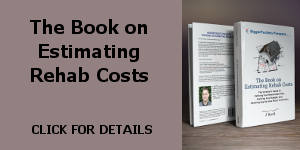I’ve been thinking a lot recently about what it takes to be a successful flipper in today’s market. It’s certainly different than it was a couple years ago (even a year ago!), but I’m convinced that if you’re diligent, analytical, and careful, it’s still possible to make a lot of money flipping properties in most areas of the country.
While I certainly don’t claim to be an expert on the subject (I’m only on my fifth property and haven’t sold all of my first four yet), I have made a number of observations over the past 8 months or so that has shaped my investing strategy and style for this market.
With a big disclaimer about the fact that what may work for me in my market may not work for you in your market, and another big disclaimer that I might flat-out be wrong about some of my observations, I thought I would take a couple posts to outline some rules I’ve come up with to be a successful flipper in today’s market…
- Best Condition & Best Price: It used to be that — to be successful — a house flipper needed to focus on having either the nicest house on the block or the lowest priced house on the block. With the number of houses on the market currently outnumbering the number of potential buyers by a very large margin, house flippers must now focus on having the house that is BOTH in the best condition AND the lowest priced among comparable homes.
I’m sure a lot of people who are considering this are thinking, “How can I offer the nicest house at the lowest price and still make money?” It’s a great question, and the answer is simple — only consider fantastic deals when you’re buying. As the old adage goes, you make money when you buy. This is especially true in today’s market; if you can’t buy low enough to put the house in great condition and still sell below market, you shouldn’t be buying.
That said, I can promise those types of deals are out there…just keep looking…
- Know Your Buyers: I was at a Real Estate Investment group meeting a couple weeks ago, when an investor who focused on rental properties asked me, “How do you expect to flip any properties? I had a friend who was buying properties worth $300K and trying to sell them for under $200K, and couldn’t sell a single one!
I’ll tell you what I told him — in my current local market, there are very few buyers who are looking for properties over $150K. Sure, there are some here and there, but for the most part, today’s buyers are first-time home buyers looking for move-in-ready properties in the $90-130K range. Why is that? It’s because these are the only buyers who are able to both qualify a loan and come up with a down-payment. (they are getting FHA loans that only require 3% down, and in some cases getting 100% financing if their household income is low enough to qualify).
So, it’s no surprise that this guy’s friend wasn’t able to sell his $300K houses for $200K — there just aren’t enough buyers at that price-point, regardless of how good the deals are.
Knowing your buyer base will allow you to appropriately focus your rehab and resale efforts — if the available buyers are looking for move-in-ready houses in the $90-130K range, you should be offering move-in-ready houses in the $90-130K range, nothing more and nothing less. I’m not saying the buyer base in your market is the same as it is in mine, just that you need to figure out what you buyer base is, AND FOCUS YOUR HOUSES ON THEM.
- Multiple Exit Strategies: Wanting to flip a house is great. Finding a house that can be successfully flipped is even better. But, in today’s market, any deal you consider should have multiple possible exit strategies — not just the possibility of a flip. And not just multiple potential exit strategies, but multiple strategies that you are convinced will work, if necessary.
For example, I like to have at least 3 of the following 5 possible exit strategies before I consider a deal:
- Wholesale to Another Investor
- Minor (or No) Rehab and Rent
- Minor Rehab and Sale to Investor
- Minor Rehab and Flip to Occupant
- Major Rehab and Flip to Occupant
If you can’t find at least two different exit strategies for a property, don’t buy it. Because in this market, there’s just too much chance that your first strategy won’t pan out, and if that happens, you want to have alternatives.
- Know Your Comps: With the market changing on a daily basis, this is no time to trust something as important as comps to unreliable sources. That means you shouldn’t be using tax appraisals (those guys don’t even go inside the house to get their estimates), you shouldn’t be using websites like Trulia and Zillow (they may be right on, but they may also be very high or very low), and you shouldn’t be trusting your real estate agent unless they actually give you the data to verify for yourself.
The only real way to find comps is to pull actual MLS (or tax record) data, and sort through it yourself. You’re looking for similar properties (pretty much same style, same # of beds and baths, same lot size, same condition) that have sold in the past 3 months within the same subdivision (or .5 mile radius). Don’t go back 6 or 12 months (the market has changed since then), don’t look at properties that are nothing like your own, and don’t look even 2 miles away (market conditions can vary drastically over even short distances).
Your agent should be able to pull all the comp data you need, but it’s YOUR responsibility to make sure the data used is applicable. Too many agents will give you data that supports a high ARV, just to get you to buy the property. Trust the data, but only if you sort through it yourself. And if you can’t find any data for your area, ask yourself why that is? Is it “out of the way?” Is it a bad neighborhood where buyers don’t want to buy if they have an alternative (and these days they do)? Or is it such a desirable neighborhood that nothing has even been listed for sale in the past year (this is a good thing)? Even lack of data is an important piece of data when it comes to comps.
I’ll post a bunch more in upcoming posts (I have a big list), and would love to get any feedback from other investors on what strategies you’re using to survive and thrive in this market…




Hi Scott, it seems like we have a similar strategy as what we have been doing in Southern California. I just wanted to let you know I enjoy your blog. You share a ton of great info!
I know your not saying don’t ever use trulia or zillow, but don’t they have accurate information on recent sales at least? (btw I never use their estimate on house worth, they are always off by at least 10-15%)
Yeh I use zillow too, but just for the recent sales and the for sale listings in the neighborhood, so I can be sure to price at the lowest or under the lowest listing in the hood. Good stuff though, I agree with it all 😉
– Hakrjak
Zillow and Trulia (and other sites) have a lot of great data…I just hate the estimated ARVs that they generate themselves like the “Zestimate”. Certainly the For Sale and the Recently Sold info is great…as well as the neighborhood statistics…
Zillow’s Zestimate values is always 25-30% high minimum in our market. I think they allow for pretty loosely matched comps, because when I do a comp search they’re comparing houses that are built 60 yrs apart.
Applying my poker background, whether you’ve got 5 flips under your belt, or 50 for that matter, it still wouldn’t provide with you with sufficient data to create a “full proof” investing strategy. Although, 50 flips and a million in revenue sure sounds like music to my ears.
I would try to incorporate the data of other investors in your market so you have a statistically relevant amount of information, then apply your knowledge and experience to “perfect” your investment strategy.
Of course, I’d probably also wager all my profits on a football game prior to boarding a plane just to make the flight more interesting:(
I don’t know if this happens all the time, but I bought my (personal) house 6 months ago for 300k, and Zillow still has it listed as sold (NOT Zestimate) for 339k. That’s a big difference.